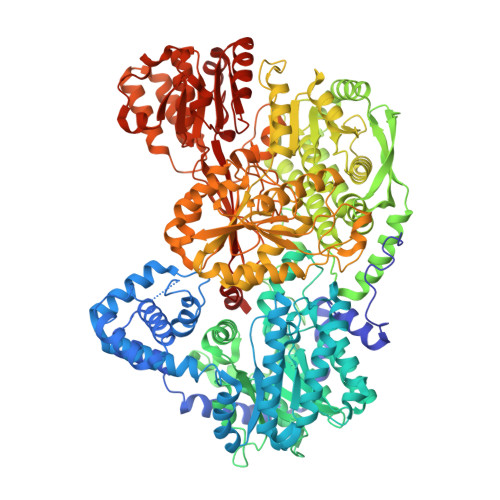Photoinduced Covalent Irreversible Inactivation of Proline Dehydrogenase by S-Heterocycles.
Campbell, A.C., Prater, A.R., Bogner, A.N., Quinn, T.P., Gates, K.S., Becker, D.F., Tanner, J.J.(2021) ACS Chem Biol 16: 2268-2279
- PubMed: 34542291
- DOI: https://doi.org/10.1021/acschembio.1c00427
- Primary Citation of Related Structures:
7MY9, 7MYA, 7MYB, 7MYC - PubMed Abstract:
Proline dehydrogenase (PRODH) is a flavoenzyme that catalyzes the first step of proline catabolism, the oxidation of l-proline to Δ 1 -pyrroline-5-carboxylate. PRODH has emerged as a cancer therapy target because of its involvement in the metabolic reprogramming of cancer cells. Here, we report the discovery of a new class of PRODH inactivator, which covalently and irreversibly modifies the FAD in a light-dependent manner. Two examples, 1,3-dithiolane-2-carboxylate and tetrahydrothiophene-2-carboxylate, have been characterized using X-ray crystallography (1.52-1.85 Å resolution), absorbance spectroscopy, and enzyme kinetics. The structures reveal that in the dark, these compounds function as classical reversible, proline analogue inhibitors. However, exposure of enzyme-inhibitor cocrystals to bright white light induces decarboxylation of the inhibitor and covalent attachment of the residual S-heterocycle to the FAD N5 atom, locking the cofactor into a reduced, inactive state. Spectroscopic measurements of the inactivation process in solution confirm the requirement for light and show that blue light is preferred. Enzyme activity assays show that the rate of inactivation is enhanced by light and that the inactivation is irreversible. We also demonstrate the photosensitivity of cancer cells to one of these compounds. A possible mechanism is proposed involving photoexcitation of the FAD, while the inhibitor is noncovalently bound in the active site, followed by electron transfer, decarboxylation, and radical combination steps. Our results could lead to the development of photopharmacological drugs targeting PRODH.
- Department of Biochemistry, University of Missouri, Columbia, Missouri 65211, United States.
Organizational Affiliation:























